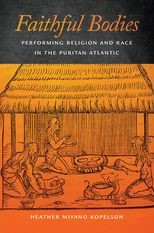Faithful Bodies: Performing Religion and Race in the Puritan Atlantic
Faithful Bodies: Performing Religion and Race in the Puritan Atlantic
Cite
Abstract
In the seventeenth-century English Atlantic, religious beliefs and practices played a central role in creating racial identity. English Protestantism provided a vocabulary and structure to describe and maintain boundaries between insider and outsider. This book peels back the layers of conflicting definitions of bodies and competing practices of faith in the puritan Atlantic, demonstrating how the categories of “white,” “black,” and “Indian” developed alongside religious boundaries between “Christian” and “heathen” and between “Catholic” and “Protestant.” The book focuses on three communities of Protestant dissent in the Atlantic World: Bermuda, Massachusetts, and Rhode Island. In this “puritan Atlantic,” religion determined insider and outsider status: at times Africans and natives could belong as long as they embraced the Protestant faith, while Irish Catholics and English Quakers remained suspect. Colonists' interactions with indigenous peoples of the Americas and with West Central Africans shaped their understandings of human difference and its acceptable boundaries. Prayer, religious instruction, sexual behavior, and other public and private acts became markers of whether or not blacks and Indians were sinning Christians or godless heathens. As slavery became law, transgressing people of color counted less and less as sinners in English puritans' eyes, even as some of them made Christianity an integral part of their communities. This transformation proceeded unevenly but inexorably during the long seventeenth century.
-
Front Matter
-
Introduction
-
Part I Defining
-
Part II Performing
-
Part III Disciplining
- Epilogue
-
End Matter
Sign in
Personal account
- Sign in with email/username & password
- Get email alerts
- Save searches
- Purchase content
- Activate your purchase/trial code
Institutional access
-
Sign in through your institution
- Sign in with a library card Sign in with username/password Recommend to your librarian
Institutional account management
Sign in as administratorPurchase
Our books are available by subscription or purchase to libraries and institutions.
Purchasing information| Month: | Total Views: |
|---|---|
| February 2023 | 1 |
| March 2023 | 2 |
| May 2023 | 2 |
| May 2023 | 2 |
| June 2023 | 2 |
| June 2023 | 1 |
| June 2023 | 2 |
| June 2023 | 2 |
| September 2023 | 2 |
| November 2023 | 3 |
| November 2023 | 3 |
| November 2023 | 3 |
| November 2023 | 3 |
| November 2023 | 2 |
| November 2023 | 3 |
| November 2023 | 3 |
| November 2023 | 3 |
| November 2023 | 3 |
| November 2023 | 3 |
| November 2023 | 3 |
| November 2023 | 3 |
| November 2023 | 3 |
| November 2023 | 3 |
| November 2023 | 3 |
| November 2023 | 3 |
| November 2023 | 3 |
| November 2023 | 3 |
| November 2023 | 3 |
| November 2023 | 3 |
| November 2023 | 3 |
| December 2023 | 1 |
| February 2024 | 2 |



Get help with access
Institutional access
Access to content on Oxford Academic is often provided through institutional subscriptions and purchases. If you are a member of an institution with an active account, you may be able to access content in one of the following ways:
IP based access
Typically, access is provided across an institutional network to a range of IP addresses. This authentication occurs automatically, and it is not possible to sign out of an IP authenticated account.
Sign in through your institution
Choose this option to get remote access when outside your institution. Shibboleth/Open Athens technology is used to provide single sign-on between your institution’s website and Oxford Academic.
If your institution is not listed or you cannot sign in to your institution’s website, please contact your librarian or administrator.
Sign in with a library card
Enter your library card number to sign in. If you cannot sign in, please contact your librarian.
Society Members
Society member access to a journal is achieved in one of the following ways:
Sign in through society site
Many societies offer single sign-on between the society website and Oxford Academic. If you see ‘Sign in through society site’ in the sign in pane within a journal:
If you do not have a society account or have forgotten your username or password, please contact your society.
Sign in using a personal account
Some societies use Oxford Academic personal accounts to provide access to their members. See below.
Personal account
A personal account can be used to get email alerts, save searches, purchase content, and activate subscriptions.
Some societies use Oxford Academic personal accounts to provide access to their members.
Viewing your signed in accounts
Click the account icon in the top right to:
Signed in but can't access content
Oxford Academic is home to a wide variety of products. The institutional subscription may not cover the content that you are trying to access. If you believe you should have access to that content, please contact your librarian.
Institutional account management
For librarians and administrators, your personal account also provides access to institutional account management. Here you will find options to view and activate subscriptions, manage institutional settings and access options, access usage statistics, and more.